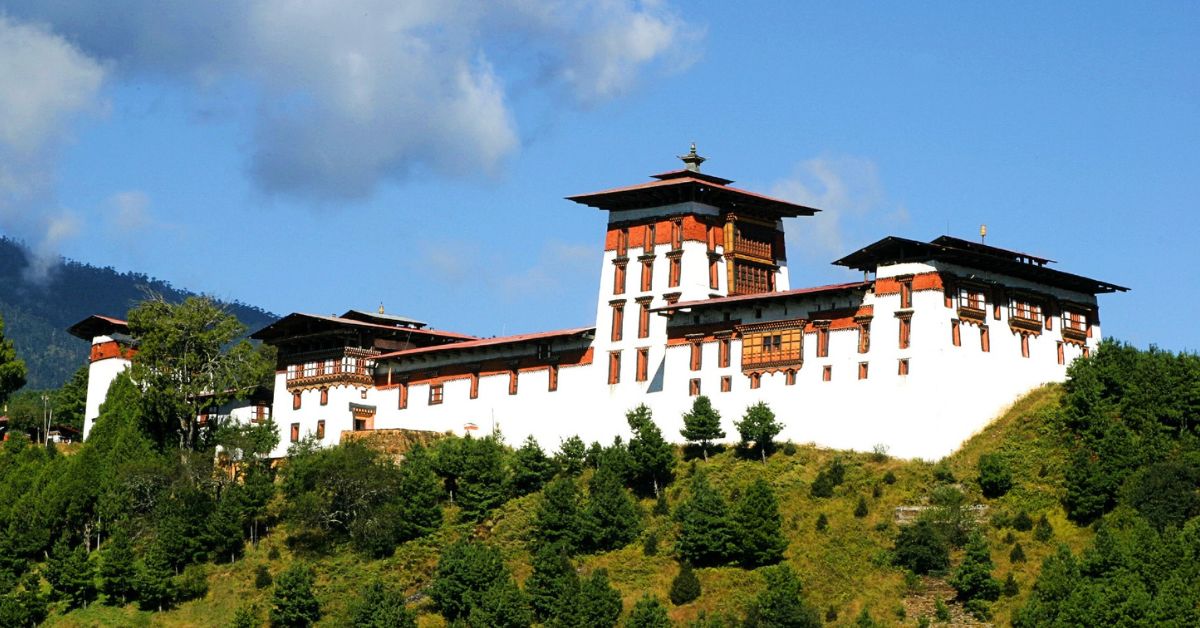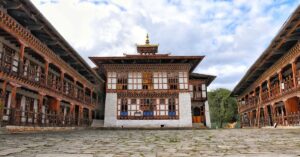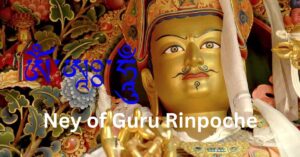Jakar Dzong, also known as Jakar Yugyal Dzong, the ‘Fortress of White Bird’, was founded by Yongzin Ngagi Wangchuk, the great-grandfather of Zhabdrung Ngawang Namgyal, in 1549. It sits on a foretold hill above Jakar town in the Chamkhar Valley of Bumthang Dzongkhag.
Jakar Yugyal Dzong has two unique features: the 50-meter-high Utse, or central tower, and the Chhu Dzong, also known as the water tower.
The Jakar Dzong served as a crucial defensive fortress for the entire eastern region during the Tibetan invasions of the 17th century. Today, it houses the administration offices and the monastic body of Bumthang District, and is popular for the annual Jakar Tshechu festival.
How to Reach Jakar Dzong
Jakar Yugyal Dzong is approximately 2 kilometers from Chamkhar town. From the city, drive to the base of the Jakar ridge and walk from there. The walk takes about 15 minutes and involves a moderate uphill climb along a narrow stone path. From the capital, Thimphu, it takes 9 hours to reach Bumthang.
Sacred Relics to See at Jakar Dzong
- The Statue of Dolma (Tara);
- Statue of Chenrezi (Avalokiteshvara);
- Statue of Mithukpa (Akshobya);
- The 50-meter-high Utse (central tower);
- A well-protected water supply source (Chhu Dzong);
- A half-round Ta dzong (watchtower).
History of Jakar Dzong
Bumthang Jakar Dzong was built by Ngagi Wangchuk in 1549.
According to the history of Jakar Dzong, Yongzin Ngagi Wangchuk first built a fortress as a temple in 1549. Before the construction, it is believed that a white bird emerged from nowhere and sat on a ridge above Chamkhar. Considering it a good omen, Lam Ngagi Wangchuk built a small monastery and named it Jakar Dzong, the “Castle of White Bird”.
However, an oral account claims that the original temple built at the eastern end of the Bumthang was not situated at a strategic point. So, a group of lamas, astrologers, and village elders decided to find a more strategic location. During the discussion, a white bird rose into the air and rested on a hilltop above the Chamkhar Valley. Seeing it as an auspicious sign, the area for the new dzong was chosen.
Jakar Dzong underwent numerous expansions and renovations due to Tibetan invasions and earthquakes, before the current Dzong was built in 1667.
Tibetan Invasion
The Tibetans invaded Bumthang Jakar Dzong three times in the 17th century.
What is the political significance of Jakar Dzong? Jakar Dzong is a historically significant fortress. It withstood three attacks from the Tibetan invasions, safeguarding the whole eastern region.
Firstly, the ruler of Tsang in Tibet, Phuntsho Namgyel, sent an army to arrest Zhabdrung Ngawang Namgyel in Bhutan. During the attack, Jakar Dzong was damaged, but the Bhutanese troops ultimately emerged victorious. Therefore, Jakar Dzong was renamed Yuelay Namgyal Dzong to honor the victory over the Tibetan military.
Secondly, the chieftain of Bumthang Chokhor attempted to control the four valleys of Bumthang. However, the Trongsa Penlop’s forces defeated the chieftain, and he fled to Tibet. He later organized a large Tibetan army and launched an attack on Bumthang. The Bhutanese troops sought the help of the protecting deities, Choe Chong Chamdal Sum. It is said that the gun mounted on the windowsill of the Jakar Dzong miraculously aimed and fired towards the enemy camp, killing two main Tibetan commanders. The Tibetan army fled in desperation, and the Bhutanese were victorious again. The dzong was named Jakar Thobgyal Dzong, where “thob” means “get” and “gyal” means “victory”.
The third and final invasion came from four different directions during the reign of the third Druk Desi, Minjur Tempa. Drongmedpa Thinley Jamtsho led the Bhutanese forces but was unable to defeat the Tibetan army. So, Lam Ngawang Rabten was sent with additional Bhutanese troops. Once again, the Bhutanese emerged victorious in the war. Following this victory, the Jakar fortress was renamed “Yugyal Dzong”. Later, Jakar and Yugyal were merged and named Jakar Yugyal Dzong, meaning the “Victorious Fortress of the White Bird”.
Renovations of Jakar Dzong
Jakar Dzong was first expanded by Yab Tenpai Nyima, reconstructed by Desi Minjur Tempa, and later renovated by Gyalsey Tenzin Rabgye. In 1897, it was destroyed by an earthquake, but was later restored by the Second King of Bhutan.
Description of Jakar Yugyal Dzong
The main statue is of Dolma, flanked by Chenregzi and Mithukpa.
Jakar Dzong features a stone-paved staircase that leads to a narrow courtyard, surrounded by administrative offices. The Dzong has two courtyards. With a circumference of over 1,500 meters, the fortress has two main unique features. They are the 50-meter-high central tower (Utse) and the “Chhu Dzong”, a well-protected water supply source.
The 50-meter-high Utse (Central Tower), attached to the main eastern wall, is distinct from most of the fortresses in Bhutan. It is situated on an outside wall without a way to circumambulate it, unlike other dzongs in the country. The upper floor of the central tower is the Gonkhang (Protector Temple).
Another interesting feature that can still be seen is the “Chhu Dzong,” a sheltered passage with two parallel stonewalls that leads to a nearby spring from the dzong and was used during ancient wars.
At the west end of the fortress is a second courtyard, which is slightly larger than the first and is also surrounded by administrative offices. Beyond this courtyard is the half-round Ta Dzong (watchtower), which is unique in itself.
Festival of Jakar Dzong
Jakar Tshechu is a three-day annual festival held at Jakar Dzong in Bumthang from the 9th to the 11th of the ninth month on the Bhutanese calendar. The Jakar festival features sacred mask dances, folk songs, and traditional dances.
Best Time to Visit Jakar Dzong
The best time to visit Bumthang Jakar Dzong is from March to May and September to November. However, the popular time to visit Jakar is during the Jakar Tshechu festival in autumn. You can visit the major pilgrimage sites of Bumthang with the Bhutan Pilgrimage Package.
Conclusion
Jakar Dzong was founded by Ngagi Wangchuk in 1549. It sits on a ridge above Jakar town in Bumthang. The Jakar Dzong has two main unique features, such as a 50-meter-high Utse and Chhu Dzong. Today, it serves as the administrative and monastic center of Bumthang Dzongkhag and is renowned for the annual Jakar Tshechu festival.
Enjoyed reading this blog? Consider subscribing!




